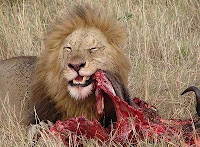I Peter encourages steadfastness and perseverance in the face of persecution (I Peter 1:1–2:10). In its closing advice, the letter warns to guard against the devil (I Peter 5:8). The letter draws on Old testament imagery and compares Satan to a lion (Psalms 22:13; Amos 3:8). The lion was a symbol of power, the king of the beasts (Proverbs 30:30) and an instrument of death (Daniel 6:16-28).
Be of sober spirit, be on the alert. Your adversary, the devil, prowls around like a roaring lion, seeking someone to devour. Resist him, standing firm in the faith, because you know that the family of believers throughout the world is undergoing the same kind of sufferings. (I Peter 5:8-9 NASB)I Peter 5:8-9 has been part of the Compline (or Night Prayer), the final church service (or Office) of the day among Catholics, for centuries.
Thomas R. Schreiner (b. 1954) explains:
The devil roars like a lion to induce fear in the people of God. In other words, persecution is the roar by which he tries to intimidate believers in hopes that they will capitulate at the prospect of suffering. If believers deny their faith, then the devil has devoured them, bringing them back into his fold...The roaring of the devil is the crazed anger of a defeated enemy, and if they do not fear his ferocious bark, they will never be consumed by his bite. (Schreiner, The New American Commentary, Volume 37 - I and II Peter, Jude, 242)If Satan were an animal, what animal would the devil be? Why? (Yes I just asked that.) In what ways is the devil like a lion?
Wayne A. Grudem (b. 1948) writes, “The metaphor is apt, for a prowling lion attacks suddenly, viciously, and often when its unsuspecting victim is engaged in routine activities (Grudem, 1 Peter (Tyndale New Testament Commentaries), 196).”
Lions do not hunt indiscriminately but rather use a highly calculated method. They choose the coolest hours to hunt which is linked to energy conservation since their hearts are relatively small. Lions usually seek prey under a cover of night and the moonless part of the night is preferred. Lions hunt less during the day due to the heat and the probability of being spotted by their prey. When they do hunt during the day, their best opportunity for making a kill is when they encounter a lone animal who is caught by surprise. They methodically stalk the prey moving closer inch by inch and strike when the animal lowers its head to graze.
Once a lion has selected its prey, it will sprint to it and attempt to grab hold of it. As lions are not endurance runners, they usually need to be within 20 yards of their quarries. Killing is generally done in two stages, first, bringing the animal down, then completing the kill. Many animals who are seemingly successful in escaping a lion’s advances die later from lacerations. Most deaths at the paws of lions occur through suffocation as a single lion will often crush its victim’s windpipe. After a success, unlike most other cats, lions prefer to eat crouching or lying down. A lion will then gorge itself, if possible, on any given kill.
Interestingly, the prey seldom struggles after it is brought down, perhaps due to the shock of being caught. Although it may seem that lions attempt to “humanely” dispatch their prey, they actually selfishly prefer quick kills so that they will be able to dine sooner.
In comparing the devil to a ravenous lion, I Peter paints the image of a calculating predator. In response to this threat, the epistle repeats its previous commands to be self controlled or “sober” (I Peter 1:13, 4:7, 5:8) and adds that the Christian need always be alert.
In what ways are you guarding against Satan?
“Put on the full armor of God, so that you will be able to stand firm against the schemes of the devil.” - Ephesians 6:11 NASB

No comments:
Post a Comment